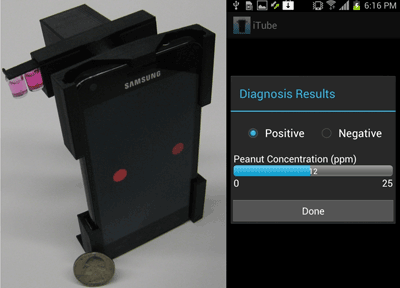Use your smartphone to detect food allergies
BY NICOLETTE EMMINO
Food allergies can be a major concern for people, especially parents with small children affected. Although eateries try to protect the public from cross-contamination, such instances can still occur during manufacturing and processing. Now a new device that hooks up to your smartphone can help detect allergens in your food.

Left image: The iTube platform works by chemically coloring allergens in a solution and measuring the concentration of color. Right image: Screen capture of the iTube app. (Image via UCLA)
A team of researchers from the UCLA Henry Samueli School of Engineering and Applied Science have developed a lightweight device that weighs just over one ounce called the iTube, which attached to your iPhone to detect allergens in food samples so you can eat out without worry.
How it works
The iTube attachment uses the cellphone’s built-in camera, along with an app that must be downloaded before use. The team says that the application runs the tests with the same level of sensitivity that a lab would.
A food sample should first be ground up and mixed with hot water and extraction solvent in a test tube. Then, a user should follow the step-by-step instructions to mix the sample with other reactive testing liquids.
The prep process takes about 20 minutes and once prepared, the sample is measured through the iTube platform using the phone’s camera and the app. The iTube kit then digitally converts the images from the phone’s camera into concentration measurements detected in the food samples.
The device provides more than just a “yes” or “no” answer when testing for these allergens. It can even tell you how much of an allergen is contained in the sample, in parts per million.
“We envision that this cell-phone–based allergen-testing platform could be very valuable, especially for parents, as well as for schools, restaurants, and other public settings,” said Aydogan Ozcan, lead researcher on the team and UCLA associate professor of electrical engineering and bioengineering.
iTube tests for allergens such as peanuts, almonds, eggs, and gluten. The results are tagged with a time and location stamp and can be uploaded directly from cellphones to iTube servers to create a personalized testing archive which can aid in allergen research for those with allergies worldwide. The team believes it could be useful for future food-related policies.
The UCLA team successfully tested the iTube using cookies, analyzing the samples to determine if they had any harmful amount of peanuts, a potential allergen. Their research was published in the peer-reviewed journal Lab on a Chip.
According to the team’s data, food allergies affect as many as 8% of young children and 2% of adults and can be life threatening. ■
Advertisement
Learn more about Electronic Products Magazine





